Muslim, Indian, and Western historians all see Akbar as the greatest ruler of Indian history. When his father, Humayun, died in 1556, Akbar became badshah (“ruler of the empire”) at the age of thirteen. Under the guidance of Bairam Khan, who had been instrumental in Humayun’s reconquests of Panipat, Delhi and Agra, Akbar instantly began seizing more territory throughout Hindustan. Bairam Khan fell from power in 1560, but Akbar continued his conquest of India and Afghanistan. By the time he died in 1605 (his reign, 1556 to 1605, corresponds almost exactly to that of Elizabeth I of England), his Empire was greater than that of Babur and included almost all of northern India.
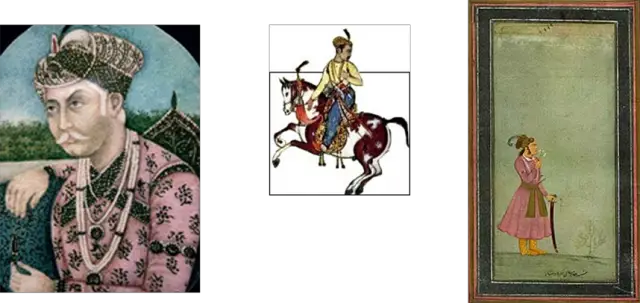
In order to govern this territory, Akbar developed a bureaucracy and a system of autonomy for the imperial provinces. Akbar’s bureaucracy was among the most efficient in the world. He put military governors, or mansabars , in charge of each region. Each governor was responsible for the provincial military and, as in the Ottoman state, was directly responsible for all abuses. Abuses of power and mistreatment of the poor or weak resulted in severe punishments and death, just as in the Ottoman Empire. Each military governor was put in charge by the badshah himself, so he could be dismissed at will. The most important part of the bureaucracy was tax collection. Akbar made several innovations. His tax, like all other states, was a land tax that amounted to one-third of the value of the crops produced on it each year. However, the tax was assessed equally on every member of the empire—a radical innovation considering that every other state in the sixteenth century rarely taxed the nobility. He also eliminated the tax assessed on non-Muslims.
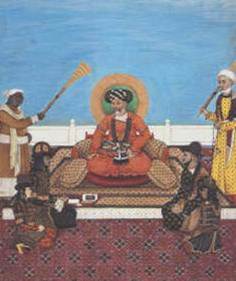 From the beginning of the Islamic
From the beginning of the Islamic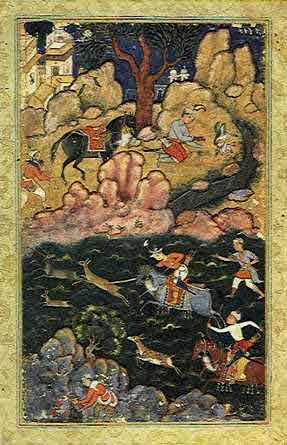 expansion, a special tax was levied on non-believers. This special tax, called the jizya , was bitterly resented all during the history of Muslim rule in India. In addition, Muslim rulers in India charged a “pilgrimage” tax on unbelievers travelling to various Hindu pilgrimage sites. Akbar eliminated this tax in 1564.
expansion, a special tax was levied on non-believers. This special tax, called the jizya , was bitterly resented all during the history of Muslim rule in India. In addition, Muslim rulers in India charged a “pilgrimage” tax on unbelievers travelling to various Hindu pilgrimage sites. Akbar eliminated this tax in 1564.
THE POLITICAL THEORY OF AKBAR’S STATE
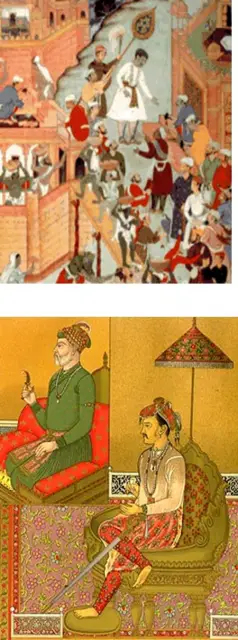
There was considerable disagreement all during the reigns of Babur, Humayun, and Akbar over the nature of monarchy and its place in Islamic society. Many Islamic scholars under Babur and Akbar believed that the Indian monarchies were fundamentally un-Islamic. At the heart of the problem was the fact that none of the invading monarchs were approved by the Caliph, but rather were acting solely on their own. The majority of Islamic scholars, however, concluded that the monarch was divinely appointed by God to serve humanity and that the Indian sultanate or the Mughal badshah was acting in the place of the Caliph.
The political theorists and Islamic scholars surrounding Akbar were deeply influenced by Shia Islam. In particular, they subscribed to the Shia notion that God had created a Divine Light that is passed down in an individual from generation to generation; this individual is known as the Imam. The central theorist of Akbar’s reign was Abu’l Faz’l, who joined Akbar’s court in 1574 and is considered one of the greatest political theorists in Islamic history. He believed that the Imamate existed in the world in the form of just rulers. The Imam, in the form of a just ruler, had secret knowledge of God, was free from sin, and was primarily responsible for the spiritual guidance of humanity. This, to a certain extent, made the badshah superior to the Shari’a , or Islamic law, and the Islamic scholars that interpreted it. Needless to say, orthodox Islamic scholars bitterly opposed this political theory, but instead advocated a close partnership between the ulama , or Islamic religious and legal scholars, and the Sultan
AKBAR’S ARCHITECTURAL VISION
Akbar, in the very employment of “cunning artists of form” from Bengal, Gujarat and other parts of India, was launching the scheme of giving a free hand to artists from various parts of the country to exploit their native genius to the fullest. Again, in almost exclusively using locally available red sandstone as building material, Akbar was not only giving vent to his aesthetic partiality but also to his sense of austerity and moderation even in royal buildings. He seems to have been his own Minister of Public Works right through his Kingship and exercised personal control in “regulating the price of building materials, the wages of craftsmen and collecting data for framing proper estimates.
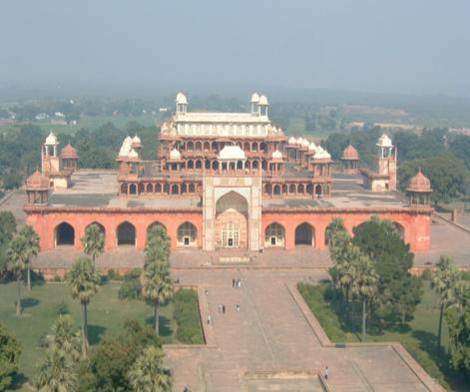 What is more, this “child of a Sunni father and Shia mother, born in Hindustan the land of Sufism at the house of a Hindu,” was singularly obsessed with one aspect of his meager formal education; from the great liberal, Mir Abdul Latif, he had fully imbibed the principles of “sulh-i-kull” or religious tolerance. Thus his builders were rarely commanded to adhere to a style consciously representing a single religion. Akbar’s directives of freedom of expression to his Indian builders were also based on conclusions drawn from what his keen and observant eyes had seen.
What is more, this “child of a Sunni father and Shia mother, born in Hindustan the land of Sufism at the house of a Hindu,” was singularly obsessed with one aspect of his meager formal education; from the great liberal, Mir Abdul Latif, he had fully imbibed the principles of “sulh-i-kull” or religious tolerance. Thus his builders were rarely commanded to adhere to a style consciously representing a single religion. Akbar’s directives of freedom of expression to his Indian builders were also based on conclusions drawn from what his keen and observant eyes had seen.
AKBAR’S STYLE OF ARCHITECT
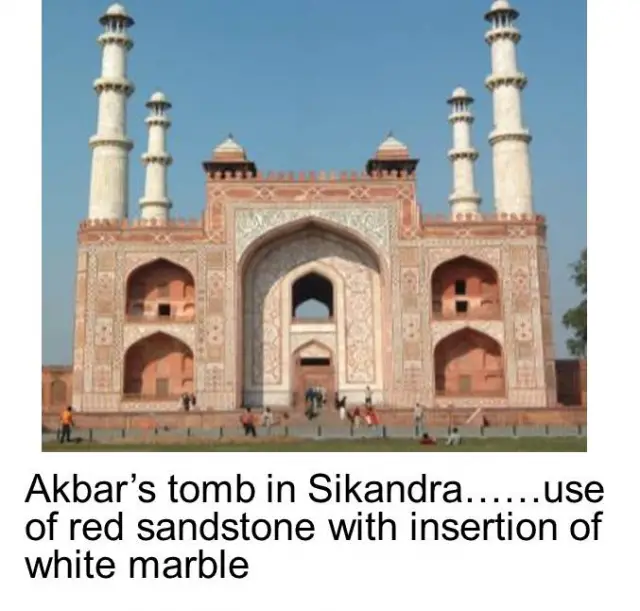 Material and construction
Material and construction
The style of building that evolved under akbar’s patronage was chiefly executed in red sandstone readily available with insertions of white marble frequently introduced for purposes of emphasis. In principle ,construction was of the trabeate order ,although the “Tudor” arch was often used but mainly in its capacity as decorative arcading as a matter of fact in its appearance but not in structure,the style was arcuate and trabeate in almost equal proportions .It is also possible to see by its character that it was not far removed from a wooden arch type. During the early mughal period , the dome was of the Lodi type, sometimes built hollow but never technically of the true double order .The pillar shafts are many sided and almost invariably in the form of bracket supports.
Where materials are concerned it was jehangir who introduced the use of marble .Building the upper storey of his fathers tomb and decorating gateway with intensive Hindu) floral inlay work in marble.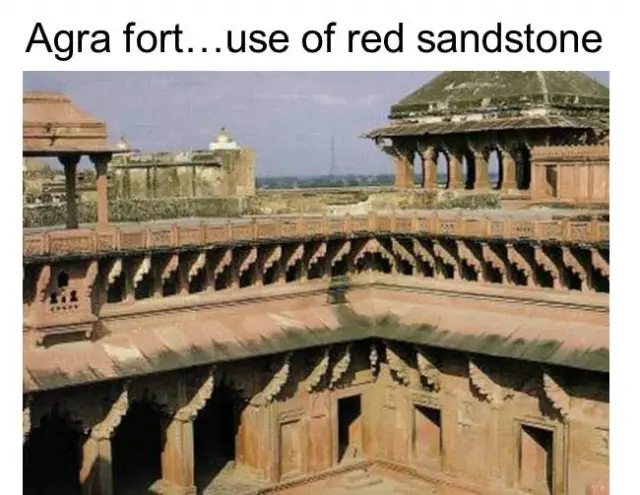
Shahjahan,carrying the tradition of innovation at sikandra,a step further, built marble minarets over the southern gate before doing the same at the taj mahal. The garden concept, somewhat ignored by akbar was extensively developed by jehangir. The jehangiri mahal also seems to be an experiment at structures with corbelled domes , corbelled flat roof, simple flat roof, vaulted roofs and brackets holding the ceiling of different chambers.
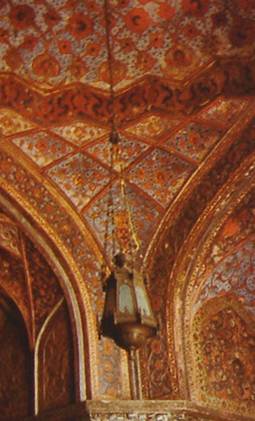
Ornamentation
Carved or boldly inlay patterns were common while painted designs were often introduced on the interior walls and ceilings. A most attractive appearance was given to the structure by means of arcades, arched recesses and other architectural and decorative features, so disposed as to add greatly to the without detracting from its real purposes. As part of the fortification. The rich and varied ornamentation consists of patterns in white marble inlay against the warm red sandstone. One motif repeated in the borders is the conventional representation of a bird, introduced into the design contrary to the koranic objection to the living form appearing in Islamic art. The buildings of the akbari period are remarkable for their animation but few are so vibrant in their character such as the gateway of the Agra fort
NEW TECHNIQUES
Akbar, the liberalist had managed to gain control over the most of India and had experienced the rich Indian tradition it is after Akbar that we witnessed the true fusion of muslim and Indian architecture In designing his own tomb he has totally moved away from the typical and built a structure of apparent Buddhist influence (multistory viharas). Akbar called artisans from all over India to build his palaces. The Indian craftsmen as masters of decoration, intently set about decorating Akbar’s red sad stone with intricate carving. The carving in the jahangiri mahal is of Gujarati wooden origin. The Rajasthani style kiosk was also well incorporated. The introduction of floral motifs (sikandra) and even more substantially humans (itmad-ud-daulah) was a major change from the geometric Muslim designs.
AGRA FORT
Interestingly, Agra Fort has a history that spans two generations of the Mughal emperors. Started during the reign of the Mughal emperor Akbar (1556-1605), the construction work on the Agra Fort continued till the reign of his grand son Shah Jahan (1627-58). Though started by Akbar in 1565, it was Shah Jahan, who constructed most of the buildings inside the fort. In
1558, at the age of 16, Akbar shifted his government from Delhi to Agra, where he made improvements to the city, giving it water supply and drainage systems. In 1565, he began to build the Agra Fort on the site of an earlier walled fort. The new Agra Fort Complex contained a palatial-city complex, and served as the seat of imperial power for Akbar, his son and successor Jahangir, and his grandson Shah Jahan. Even after Shah Jahan shifted the capital to Delhi in 1648, Agra continued to be an important administrative and palatial center.
The walls of the Fort, like most of Akbar’s numerous buildings within them, are faced in red sandstone. The walls are inlaid with careful white marble detail, creating a sense of richness and great power. Of Akbar’s several palaces, only the Jahangiri Mahal, a zenana, or women’s palace, remains to this day.
Much of the rest of his work was cleared to make way for his grandson Shah Jahan’s palaces and gardens of white marble, built between 1627 and 1648. The complex includes the large Diwan-i-Am (the Hall of Public Audience), the Diwan-i-Khas (the Hall of Private Audience), mosques, a long bazaar, palaces, formal gardens, and pavilions. It has been observed that drawing from both the Islamic and Hindu traditions, the Agra Red Fort complex as we find it now is a product of the first truly Mughal style. It served as an influential example to later construction throughout the empire, notably at the Red Fort in Delhi.
Situated on the bank of river Yamuna, the Agra Fort today, stands as a citadel of the past that has witnessed centuries slip by. Built in red stone, the Agra fort stretches almost two kms. on the bank of the Yamuna. A huge wall that stands 69 ft in height encircles the crescent shaped fort. The fort is flattened on the east with a long, nearly straight wall facing the river. Fort’s colossal double walls rise 69 ft in height and measure 2.5 km in circumference encircled by a moat and contain a maze of buildings which form a small city within a city. With only two main gates built to enter the fort, the impregnable stature of the fort becomes amply clear. The two gates are named the Delhi gate and the Amar Singh Gate. Once inside the Agra Fort, one comes across a number of mosques and palaces, most of them are built in white marble and red stone during the reign of Akbar, Jehangir and Shah Jahan. At one point of time in the 16th century, the fort used to house a small city. The so-called Jahangiri Mahal was probably built by Akbar for his son Salim at a later stage, and fortunately escaped the eyes of Shah Jahan’s demolition squad.
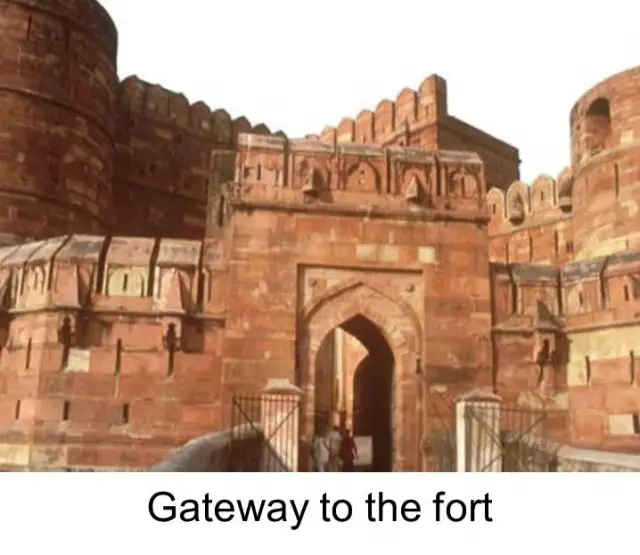
Khas Mahal is another prominent palace in the Agra Fort built by Shah Jahan in 1637 as his private palace that overlooks the Angoori Bagh (Grapes’ garden). Another palace, Diwan-I-Khas, was built around the same time as the Khas Mahal as a hall of private audience and was used by Shah Jahan to receive kings, dignitaries and ambassadors.
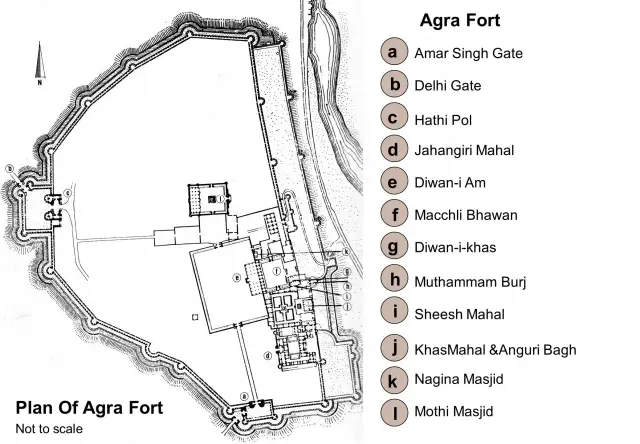
THE JAHANGIRI MAHAL
The so-called Jahangiri Mahal in the Agra fort is only the precursor to the innumerable structures put up during Akbar’s tenure of 56 years as Emperor of India. This is the first notable building as one enters through the Amar Singh Gate and emerges out of the passage. Situated north of the gate at the end of a spacious lawn, the Jehangir’s palace was built by Akbar as a residence for his son Salim. The Man Mandir at Gwalior probably caught Akbar’s fancy for it highlighted the best in the Hindu and Islamic traditions of architecture. The use of coloured glazed Tiles and domed canopies on the exterior were as positively of Persian origin as the interior arrangements which were emphatically Hindu. The largest private residence in the fort, it is a blend of Hindu and Central Asian architectural styles.
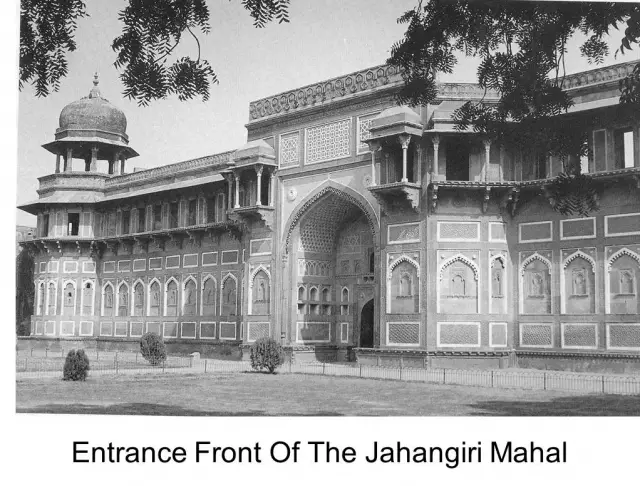
The Mahal is reached through an impressive gateway. The two-storey front facade of the building composed of a central arched opening, and deep horizontal chajjas over a wall of blind arches, flanked by octagonal domed turrets, has only a little to do with
The interior courts and halls, however, evoke the spirit of the Hindu prototype. Its inner courtyard consists of a two storey facade of beautiful halls, profuse carvings on stone, heavy brackets exquisitely carved with animal and floral motifs, piers and cross beams with remnants of the rich gilded decorations which once covered much of the structure. The Jahangiri Mahal is essentially a configuration of rooms and chapels freely dispersed around two courts that are aligned along a central axis. The court overlooking the Yamuna river was obviously the private zenana court while near the entrance was the reception court.
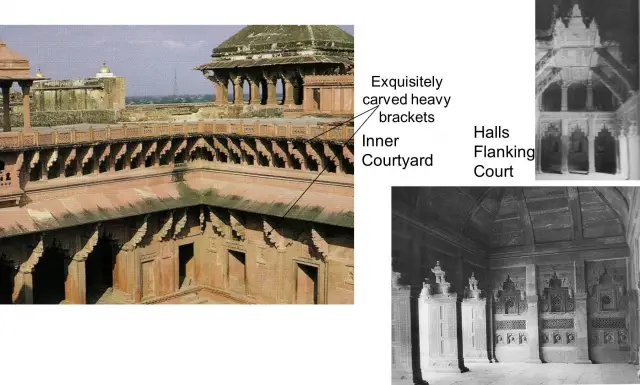
The entire scheme consisting of typical Jain toranas sprung across trabeate openings, richly carved stone piers and brackets and inclined struts supporting chajjas and roofs is evocative of that of the palace of Man Singh.
DELHI GATE AND AMAR SINGH GATE 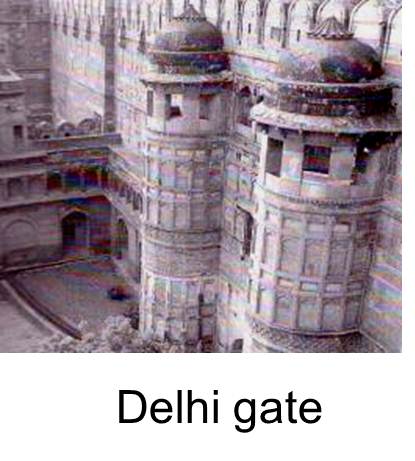
The main entrance is the Delhi gate ,to the west. Before the twin towered hathi pol the rectangular barbican has a canted entrance forcing the line of approach up a steep, restricted ramp parallel to the walls and through three obtuse and acute angled turns. Balconies on indigenous corbels relieve the semi-octagonal, chattri crowned towers. One of the most notable example of syncretism, symbolizing the indestructible power of the empire, is a panel which shows elephants overcome by a hybrid winged beast , reminiscent of Assyrian griffin but comparable to the monsters of Hindu iconography, with the neck and ears of a horse , the legs and tail of a lion’ the tusks and trunk of an elephant. The hathi pol took its name from twin statues of elephants on pedestals to either side of the portal,destroyed by the iconoclastic Aurangzeb.
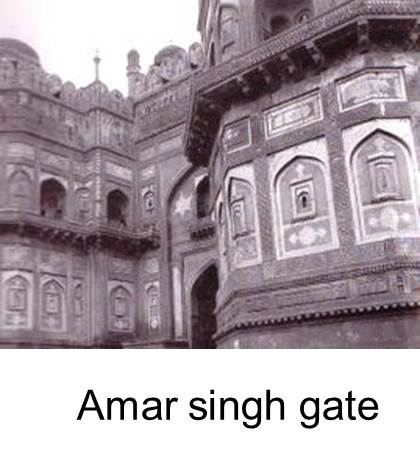 The Amar Singh gate to the south is defended by two barbicans , the outer one an irregular wedge between the inner and outer curtain walls, the inner one a rectangle forcing the line of approach through a 90- degree turn. The main portal has an elegant gallery and blind arcading in superimposed tiers,enhancing the sense of height already drawn from the compact massing though the turrets rise no higher than the battlements.
The Amar Singh gate to the south is defended by two barbicans , the outer one an irregular wedge between the inner and outer curtain walls, the inner one a rectangle forcing the line of approach through a 90- degree turn. The main portal has an elegant gallery and blind arcading in superimposed tiers,enhancing the sense of height already drawn from the compact massing though the turrets rise no higher than the battlements.
KHAS MAHAL
Built entirely of marble by Shah Jahan in 1637, the Khas Mahal or the Private Palace demonstrates distinctive Islamic-Persian features. The enclosure has three pavilions overlooking the Yamuna, with a fountain opposite the central pavilion. The central pavilion an airy edifice, used by the emperor as a sleeping chamber has three arches on each side, five in front, and two turrets rising out of the roof. It overlooks the Angoori Bagh (grape garden). The Mahal is flanked by two golden (copper) pavilions, one with white marble and was supposedly decorated with gold leaf, while the other is made with red stone, which were meant for the prominent ladies of the harem. Khas Mahal is believed to be a finest example of paintings on white marble. On the three sides of the Grape garden are residential quarters of women.
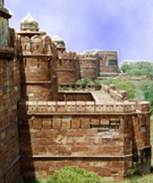
The mosques, Nagina Masjid and Mina Masjid, within the Agra Fort, were used bythe royal family and the Mughal courtiers for prayer services and the Mina Bazar was a small market where the ladies of the Zenana could shop for perfumes, clothes, cosmetics, and jewellery.
MUSAMMAN BURJ: 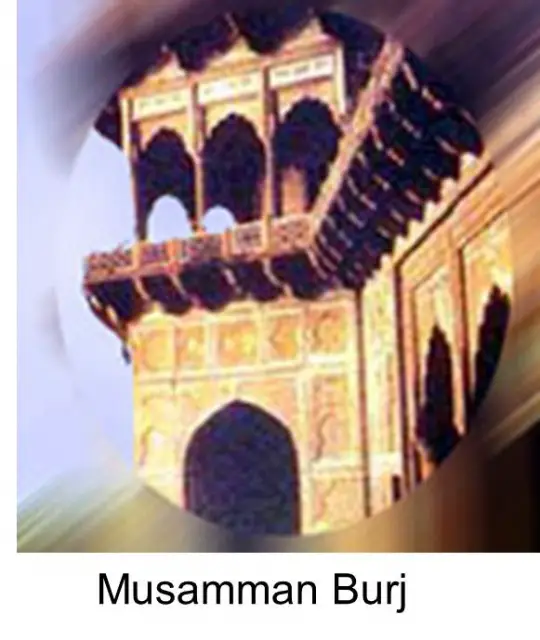
On the left of the Khas Mahal is the Musamman Burj, an octagonal tower with an open pavilion build by Shahjahan for his beloved wife Mumtaz Mahal. It is made of delicate marble lattices with ornamental niches for the ladies of the court to gaze out, unseen. The chamber with a marble dome on top, is surrounded by a verandah with a beautiful carved fountain in the center. The tower looks out over the River Yamuna and is traditionally considered to have one of the most poignant views of the Taj. This is where Shah Jahan spent his last few years as a captive of his son Aurangazeb and where he lay on his death bed, gazing at the Taj.
DIWANI-I-KHAS:
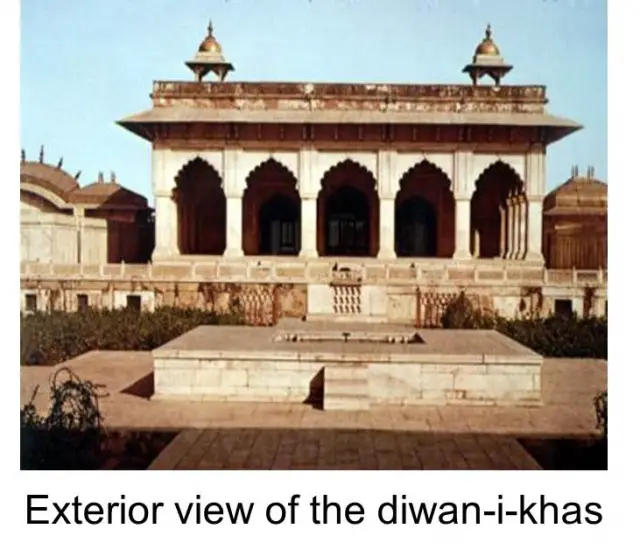
Diwan-I-Khas (hall of private audience) built by Shahjahan in 1636–37 was used to receive kings, dignitaries and ambassadors. It is a three sided pavilion with a terrace of fine proportions. Outside the structure is the marble throne terrace, where a pair of thrones were kept. The black throne belonged to Jehangir. Presently, entry is not allowed inside Diwan-i-Khas.
SHEESH MAHAL:
Opposite to the Mussaman Burj and just below the Diwan-i-Khas hall, at the northeastern end of the Khas Mahal courtyard is the Sheesh Mahal or the Glass Palace. It is believed to have been the royal dressing room and its walls are inlaid with tiny mirrors, one of the best specimens of glass-mosaic decoration in India. The Sheesh Mahal is composed of two large halls of equal size, each measuring 11.15m x 6.40 m. Both are connected in the centre by a broad arched opening and on the sides by two narrow passages.
MACCHHI BHAWAN:
Opposite to the Diwan-i-Khas is the Macchhi Bhawan, a grand enclosure meant for harem functions. The emperor sat on the white marble platform of the Diwani-i-Khas facing this courtyard. It once contained pools and marble fountains which were carried off by Jat Raja Surajmal to his palace at Deeg. On another side stands a small mosque built for Shahjahan by his son Aurangzeb.
HAMMAM-I-SHAHI:
To the right of Diwan-i-khas is the Hammam-i-Shahi or the Shah Burj. It is an airy apartment, attached to the residential quarters which was used as a summer retreat.
DIWAN-I-AM:
The Hall of Public Audiences, made of red sandstone, was constructed by Shahjahan. It is here the emperor met officials and commoners and listened to the petitioners. The women of the palace could watch the court without being seen by others from the pavilion through jali (lattice) screens. The open sided, cusped arched hall (64x23m) built of plaster on red stone, is very impressive. The throne alcove of richly decorated white marble completed after 7 years work in 1634 was used to house the famous Peacock Throne, later shifted to Delhi by Aurangazeb and was finally carried away to Iran.
The Nagina Masjid or the gem mosque is a private mosque raised by Shah Jahan with typical cusped arches for ladies of the court. There is Mina bazaar for the royal ladies to buy things from the marble balcony beneath the Nagina Masjid.
The Moti Masjid near the Nagina Masjid is a perfectly proportioned pearl mosque built in white marble. This grand mosque has three domes in white marble raising their heads over the red sandstone wall.
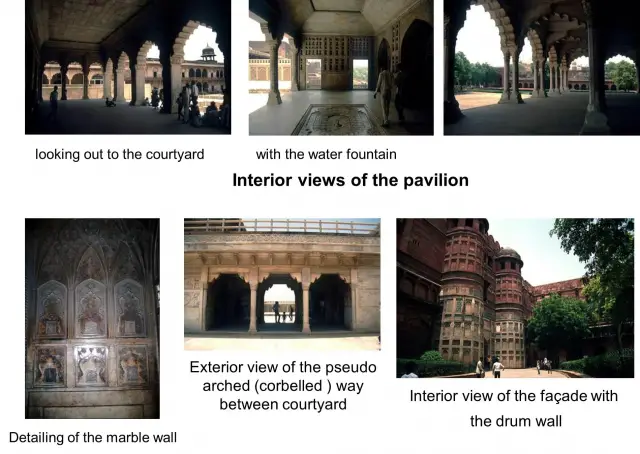
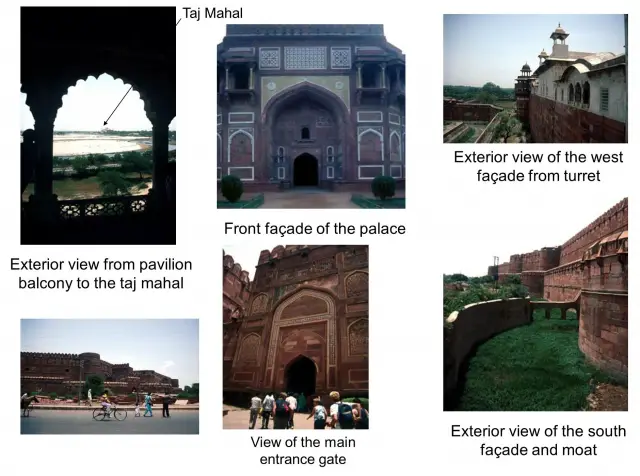
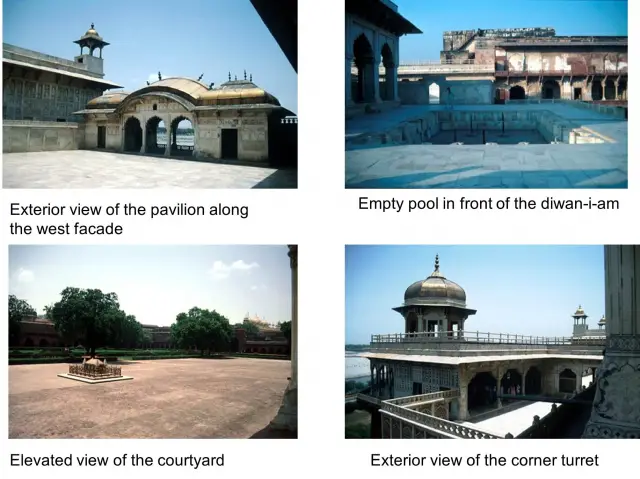
THE GREAT MAUSOLEUM OF AKBAR
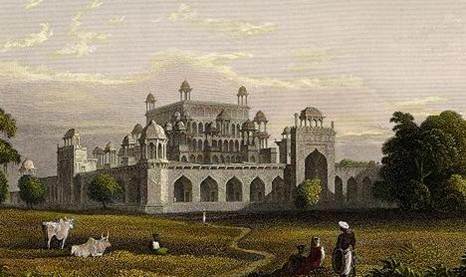
A tomb of Akbar broad paved causeaway leads to the tomb, which has five storeys and is in the shape of a truncated pyramid. The main tomb has a unique square design which is unparalleled by all other Mughal buildings. The entrance to Akbar’s tomb in Sikandra is under a huge arched gateway, similar to the Buland Darwaza at Fatehpur Sikri. There are beautiful calligraphic inscriptions on the white marble front of the gate. As you enter the gate you will see a formal garden in the charbagh tradition, and the situated at the center.
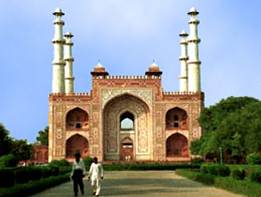 The ground floor has spacious cloisters on all the four sides except in the middle of the southern side. The cloisters are divided by the numerous bays by massive piers and arches. A vestibule, which has been ornamented very profusely with exquisite carvings, occupies the centre of the southern side, aritstic paintings and inlay work in geometric and floral designs.the tombstone of Akbar is placed in the middle of this room. Akbar’s daughters, Shakrul Nisha Begum and Aram Bano are also entombed in this floor.
The ground floor has spacious cloisters on all the four sides except in the middle of the southern side. The cloisters are divided by the numerous bays by massive piers and arches. A vestibule, which has been ornamented very profusely with exquisite carvings, occupies the centre of the southern side, aritstic paintings and inlay work in geometric and floral designs.the tombstone of Akbar is placed in the middle of this room. Akbar’s daughters, Shakrul Nisha Begum and Aram Bano are also entombed in this floor.
STYLE OF ARCHITECTURE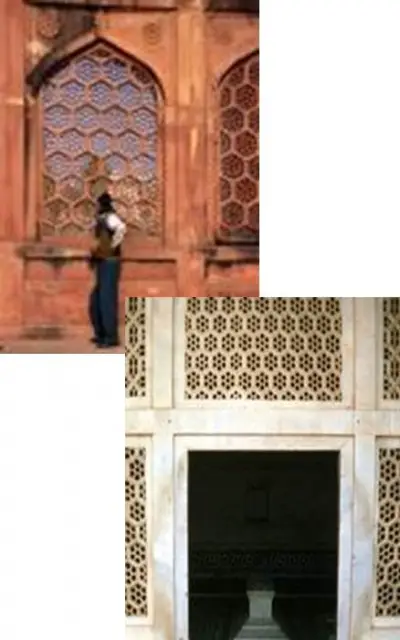
- Akbar’s tomb is a medley of architectural styles, displaying more interest in experimentation than harmony of design. The sloping dripstones, finials surmounting all the domes, balcony windows and pierced screens are all indigenous Hindu elements of architecture. Based on the pillar and beam principle, the tomb is built like a wedding cake in tiers, using the carved columns and brackets typical of Hindu construction to create the openings on the upper levels. But the pointed arches surrounding the base are Islamic, as are the inlaid geometric designs around the archways.
- The tomb of Akbar, though Islamic in spirit, is a blend of styles. The magnificent entrance, use of exquisite patterns, excellent jali work (intricately perforated decorative stone screens), fine Persian style calligraphy, the charbagh garden layout (four-quartered garden layout, with the main building at the center), etc., are representative of Islamic influence.
- India’s craftsmen were masters of stone-carving and the art of inlay, preferring graceful organic motifs from nature to the more formal geometric and stylized floral designs of Persian origin. Built by Jahangir, the tomb shows far less of the deep figurative stone-carving employed so prolifically at Akbar’s Red Fort in Agra, but several of the domes and the arched ceiling of the tomb give a spectacular display of colorful patterns created with the exuberant fluidity that is the mark of Hindu craftsmanship.
- Large panels of superbly crafted jali (filigree) screens form the outer wall of the verandah on all four sides. Akbar’s grave lies in the basement, reached through a portico covered with gorgeous stucco paintings in gold, blue, and green floral arabesque of Persian inscriptions
GARDEN AND WATER-DEVICES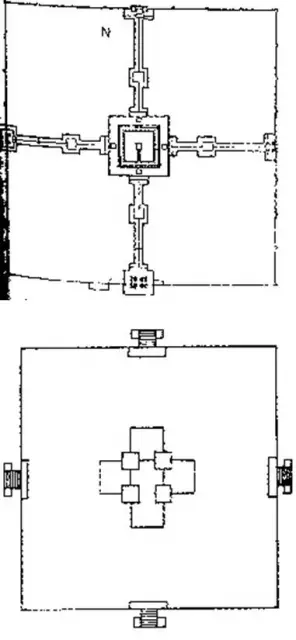
- The tomb stands in the centre of a vast garden which is enclosed by high walls on all sides. The middle of each enclosing wall is a monumental gateway. The main gateway is on the south side while the other three, planned for architectural symmetry, are ornamental only and do not function as gateways, in the right sense of the term. In fact, these are full-fledged mansions.
- This plan is similar to the plan of the Sarvatobhadra Temple Mire by inspiration, as it appears, than by accident. The whole garden has been divided into lour equal quarters on the conventional char-bagh or chahar-bagh (four-quartered) plan. each quarter separated by a high and broad terrace or causeway with a narrow, shallow water-channel running in its centre and raised footpaths on the sides.
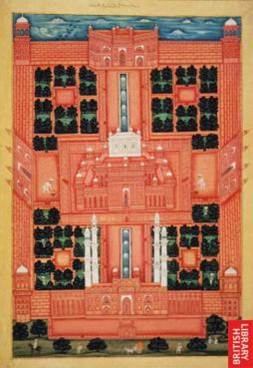
• These four minarets appear here in this region for the first time. They are just superimposing the gateway and, though a unique feature, they are attached and subsidiary to it. That their purpose was purely ornamental can scarcely be doubted. They occupy the angles of the gateway.
• Conventionally, this space would have been occupied by chhatrisas are there on the main tomb. Why then these minarets were not used on the main tomb, instead of the main gateway?
• They rise gracefully high into the sky, as if carrying the whole body of the gateway with them.
GARDEN AND WATER-DEVICES
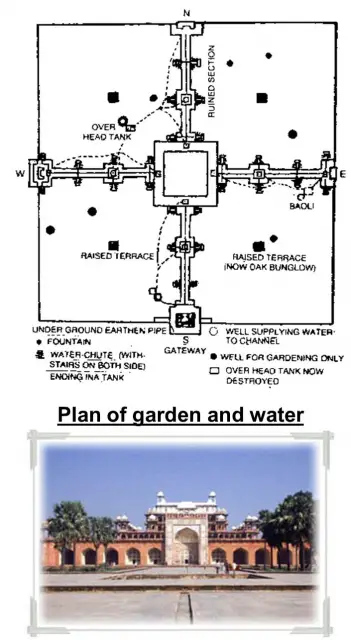
- The tomb proper is connected with the four- gateways by these four causeways which measure 75′(22.86 m) in breadth and are raised sufficiently above the level of the garden, from which they are approached by means of a number of regularly disposed staircases, each containing a cascade (water-chute; chadar) in its middle and a lily-pond into which water descended and then flowed into the stone water-courses which originally irrigated the garden.
- Each terrace has in the centre a raised tank with a fountain. Four tanks have also be formed in the centre of the four sides of the main platform on which the mausoleum Stan(. each one facing it. They also have fountains, one each. These fountains were inlets the outlets being provided in each case by the overflowing of water into the channels.
- A large baoli (step-well) in the south-east quarter were, however, reserved for supplying water to the fountains and the channels. Overhead tanks were built to ensure adequate water in the fountains.
- Water was ultimately passed into the garden where it was used to irrigate the flower-beds and tree-avenues which were the chief attraction of the garden. A large tank on a raised chab0tara (platform) was also built in the centre of each quarter.
IDEA OF SUPERIMPOSING : A GATEWAY BY A SET OF FOUR MINARETS ?
- Such minarets have not been mentioned by the Silpa texts which have discussed several free-standing `stambhas‘ under the `Sucikachanda‘ otherwise, and no theory has: been prescribed for their use, and this feature cannot be ascribed to ancient Indian art:
- Assuming that Jehangir adhered strictly to the original plan and design of the Tomb which had been conceived, worked out and finalized by Akbar, the credit of its introduction here may be given to the latter (Akbar). But how and from where did he get the idea of superimposing : a gateway by a set of four minarets?
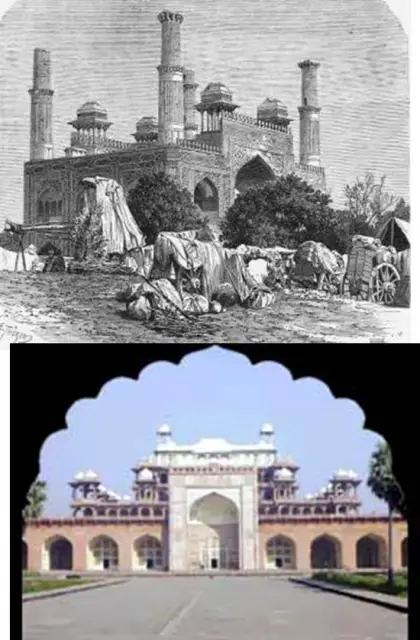 The minarets of the Char-Minar were already famous when Akbar began his campaign in the Deccan in 1599 and, presumably, their paintings were in circulation and, though have no direct connecting evidence, it is quite likely that Akbar was inspired by the idea these minarets superimposing a formal building and he had already worked out a plan to build them on the formal gateway of his proposed tomb when he returned from there.
The minarets of the Char-Minar were already famous when Akbar began his campaign in the Deccan in 1599 and, presumably, their paintings were in circulation and, though have no direct connecting evidence, it is quite likely that Akbar was inspired by the idea these minarets superimposing a formal building and he had already worked out a plan to build them on the formal gateway of his proposed tomb when he returned from there.- Minarets attached to the central arch of the facade, or to its sides, were used success in the mosques of Ahmedabad during the 15th and early 16th centuries under the Sultanate of Gujarat. Attached minarets were also used in the mosques of Burhanpur, where Akbar stayed for a considerable period of time. He adopted minaret in a modified form.
STRUCTURE OF THE TOMB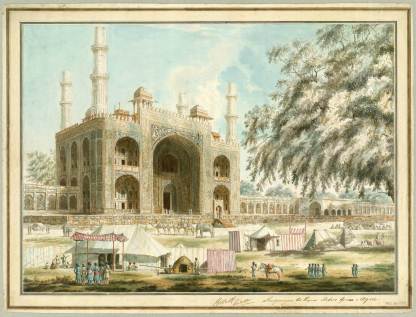
This elegant monument is located at Sikandra, 4 kms away from the city of Agra. Construction of this mausoleum of Emperor Akbar, which was started by Akbar himself, was completed by his son Jehangir. The monument is a perfect coalescence of Hindu, Christian, Islamic, Buddhist and Jain motifs. The structure gives vital insight regarding the evolution of Mughal architecture- from the Humayun’s tomb in Delhi to Akbar’s Tomb in Sikandra finally to the Taj Mahal.
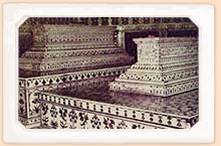 Three-storey-minarets, built in red sandstone and replete with exquisite inlay work, rise from the four corners of the tomb. The mausoleum is flanked by a beautiful garden. The Baradi palace in the gardens was built by Sikander Lodhi. A paved causeway leads to the five-storied tomb, which is in the shape of a truncated pyramid. The unique square design of the main tomb remains unrivalled by all other Mughal buildings.
Three-storey-minarets, built in red sandstone and replete with exquisite inlay work, rise from the four corners of the tomb. The mausoleum is flanked by a beautiful garden. The Baradi palace in the gardens was built by Sikander Lodhi. A paved causeway leads to the five-storied tomb, which is in the shape of a truncated pyramid. The unique square design of the main tomb remains unrivalled by all other Mughal buildings.
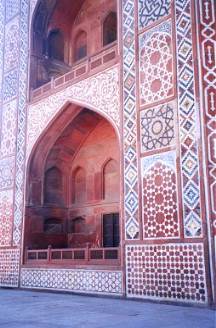
DESIGN AND ARCHITECTURE GROUND FLOOR
All the four sides, except the middle of the southern side, have spacious cloisters which are divided by massive piers and arches. The centre of the southern side is adorned with a vestibule, which has been blazoned with exquisite carvings, splendid paintings and inlay work in geometric and floral designs. The tombstone of Akbar lies in the middle of this room. Akbar’s daughters, Shakrul Nisha Begum and Aram Bano are also entombed in this floor.
SECOND STOREY OF AKBAR’S TOMB
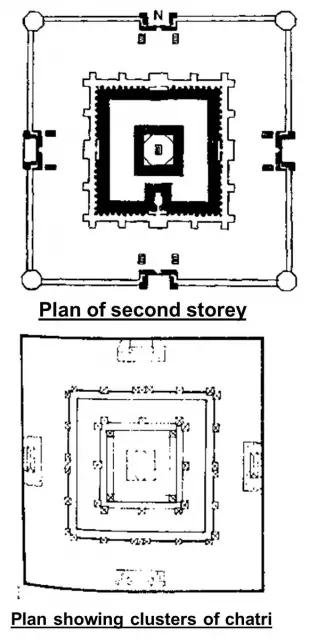
- The second storey measures 182′-6″ (55.62 m) square and occupies the centre of the spacious terrace which has a voluminous octagonal 8-pillared chhatri 17′ (5.18 m) in diameter on each corner, surmounting the tower attached to each corner of this plinth or base. 1t has an arched verandah on each side, composed of 23 bays.
- Arches made of two stone slabs on trabeate system like those of the Jami’ Masjid of Fatehpur Sikri are supported on slender pillars. Some bays break forward to support the third storey.
- Chhatris attached to each side exteriorly, superimposed on intermittently projecting bays, have been inspired, obviously, from the tomb of Muhammad Ghauth at Gwalior where a modest beginning of this pleasing feature was first made. Here, cluster of these square chhatris each of which stands on an ornamental platform and is composed of pillars, brackets, chhajja, frieze and white marble cupola roof, engulfs the main body of the tomb most artistically. Each central chhatri has a chaukhandi roof.. They harmonize well with the pillared arcade and produce an extremely pleasing effect of deep shadows which work wonders on the aesthetic sense of the beholder, almost unconsciously.
THIRD STOREY OF AKBAR’S TOMB
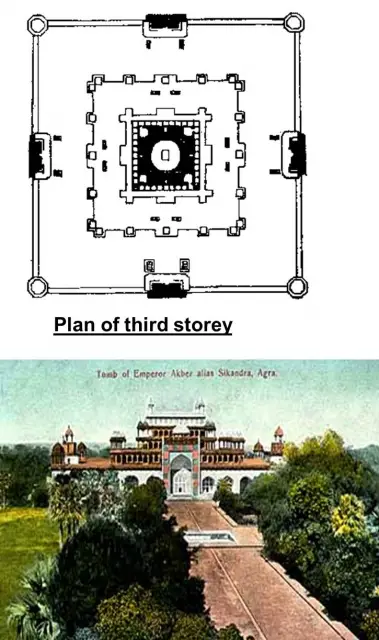
- The third storey again diminishes in size being 103′-9″ (31.62 m) side. It has similar arcade and cluster of chhatris on each side .Cupolas of some chhatris are tastefully glazed-tiled in blue, green and yellow. All edges are protected by jalied balustrades which feature was used on the main terrace but not on the edges of the second storey.
- Jali panels have exquisite geometrical designs in innumerous varieties which it is impossible to comprehend unless classified into such groups as Trigon, Square, Pentagon, Hexagon, Octagon, Decagon, Dodecagon, Star and Swastika, in accordance with the key or chief motif of the design.
- The architect of the Tomb of Akbar had a fascination for Jali-art and he has used jalis almost everywhere he could without spoiling the architectural coherence, and without doubt he had the services of the best geometers of the age at his disposal. In each of the four corners of this storey is a small room 9′ (2.74 m) square.
FOURTH STOREY OF AKBAR’S TOMB
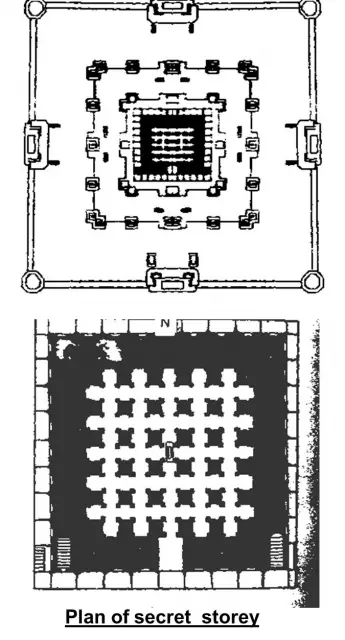
- The fourth storey is stilt smaller measuring 89′-1″ arrangement (27.16 m) side. It has identical of arches supported on pillars, and chhatris attached exteriorly to each façade.
- A secret storey exists within the main body of the tomb on this floor . At present it is accessible through a narrow opening which is 6′ (1.83 m) above the pavement of the verandah which is on the south side and it can be entered only by means of a ladder.
- Its interior is composed of five low and narrow corridors from east to west and an equal number of them running from north to south, bisecting each other at right angles. Massive piers support the huge stone beams which makeup the ceiling which is hardly 5′-6″ (1.67 m) high.
- It is curiously brick masonry construction. More surprising is the existence of a brick masonry tombstone at its centre.
- Why was a tombstone concealed in a secret storey and, that too in such a miserable condition?
FIFTH STOREY OF AKBAR’S TOMB
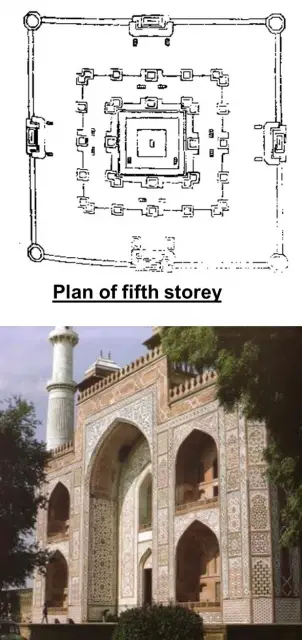
- The fifth floor is entirely made of white marble which is in contradiction to the lower storeys which are finished in red sandstone. It has a central square court open to sky of (21.34 m) side, which is surrounded by cloisters (dalan) on all the four sides on a raised level .
- Each cloister measures 89′-1 ” (27.16 m) exteriorly being equal fourth storey. It is 9′(2.74 m) wide and is divided into eleven bays on each side, by pillars and arches , each made of two slabs, the superincumbent toad resting horizontally.
- These are thus ornamental arches only. There are 40 bays altogether. Except for the comer bays which have vaulted ceiling supported on four arches of comer squinches, in typical chahar-taqr system, all tastefully painted.
- There are, thus, three tombstones in this mausoleum: one presumably on the grave in the crypt in the lowest storey, and the two others in fourth and fifth storeys being cenotaphs. To provide cenotaphs or replicas was an old custom. Even the earliest Muslim tombs of the Delhi Sultanate, e.g., those of Sultangarhi (c. 1232) and Iltutmish (1236) have cenotaphs above the original graves. It may be traced as far back as to the ancient Egyptian burial practices when a king had two tombs, one for the real burial and the other only with a cenotaph, situated, not one over the other but, at a long distance from each other, as in the Mastaba tombs.”
AKBARS TOMB: A CONTROVERSIAL ISSUE?
 Akbars tomb is unlike the tombs of the sayyids, lodis,or surs who buried their royal personnel in impressive domed structures. It is also altogether different from his fathers tomb at Delhi. The proportions also differ greatly while each successive tier diminishes uniformly in the former, as also in the Great Kailash of Eilora. in the latter the size of the second storey is abruptly reduced in comparison to the ground storey and the fourth and fifth storeys are of equal size.
Akbars tomb is unlike the tombs of the sayyids, lodis,or surs who buried their royal personnel in impressive domed structures. It is also altogether different from his fathers tomb at Delhi. The proportions also differ greatly while each successive tier diminishes uniformly in the former, as also in the Great Kailash of Eilora. in the latter the size of the second storey is abruptly reduced in comparison to the ground storey and the fourth and fifth storeys are of equal size.

The open pillared chhatris of Akbar’s Tomb cannot be compared with the cells of the Rath, their prototype is at Fatehpur 5ikri and the Tomb of Muhammad Ghauth at Gwa4ior. The former is a masonry construction while the latter is a rock-cut, mono4ithic which has a spherical superstructure. The two belong to different lands, ages, cultures, peoples, styles, orders and techniques.
Thus the measurements are as follows:
Square Side Height
I Storey 34i’ (103.94 m) 30′ (9.14 m)
II Storey 182′-6″ (55.63 m) 15′ (4.57 m)
III Storey 103′-9″ (31.b1 m) 15` (4.57 m)
IV Storey 89′-1″ (27.15 m) 15′ (4.57 m)
V Storey 89′-1″ (27.15 m) 15′ (4.57 m)
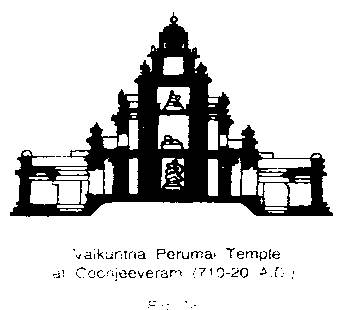
- The design of Akbar’s Tomb can be better compared with Vaikuntha-Perumal Temple of Coonjeeveram which also has five storeys and, in this case, tiers also do not recede uniformly. But it is merely co-accidental that the two are so alike in appearance. As a matter of fact, the architect of Akbar never derived any inspiration from the Coonjeeveram prasada. He composed its design with the help of the ideas gathered from earlier Mughal buildings, viz., the Tomb of Humayun at Delhi, Tomb of Muhammad ,Ghauth at Gwalior and the buildings of Fatehpur Sikn.
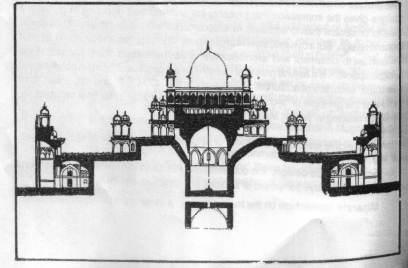
- The fifth storey of the tomb appears to be incomplete as it does not have a dome or barahdarF, This storey which is all of white marble has four square chhatris at the angles and a raised platform in the centre of the open court having profusely carved cenotaph and pedestal. A dome could have decently covered the central platform and also filled in the void which at present exist between the chhatris on the superstructure and the scholars have been discussing.
- In fact, their surmise that a dome was originally planned to superimpose the building is strengthened by a comment of William Finch who visited Agra contemporarily in 1610-11 and noted: “At my last sight thereof, there was only overhead a rich tent, with a shamiana over the tomb. As the monument now stands, the pyramid has a truncated and unmeaning aspect. The total height of the building now is a little more than 100′ to the top of the angle pavilions; and a central dome 30′ or 40′ higher, which is the proportion that the base gives, seems just what is wanted to make this tomb as beautiful in outline and in proportion as it is in detail. Had it been so completed, it certainly would have ranked next the Taj among Indian mausolea.
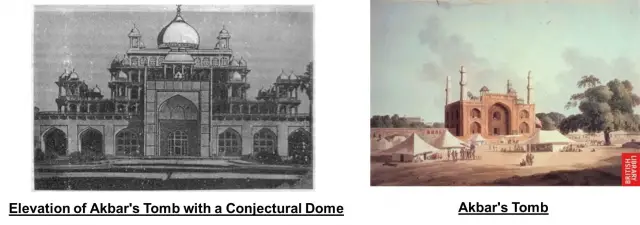
- There is hardly any doubt that dome was a logical necessity to provide a suitable apex to the pyramidal elevation , and the building as it at present stands appears to be incomplete. The platform is supported on extra-strong massive piers and huge stone boulders in the secret storey, and adequate provision to support such a dome has also been structurally made. But the view that Jehangir omitted it because he did not like it and he changed the original plan of Akbar is not convincing. He had no reason to deviate from the original plan which he is recorded to have adhered to faithfully and, in fact, those portions which had violated this plan were ordered to be rebuilt. Jehangir lived for another 15 years and there could be no reason to leave the grand mausoleum of his father, whom he deeply adored, incomplete.
- As it appears, a dome was not there in the original plan itself. Akbar did not use any dome in his palatial mansions at Agra are some domes in his buildings at Fatehpur Sikri, they are all used in a subsidiary posi6on. He did not like his tomb to be predominated by a dome as it would have certainly done. and it was designed without it, with the characteristic features of the Jamuna-Chambal region. ft was planned to be dome less and it belongs essentially to this class.
SOME DISTINCTIVE FEATURES OF THE TOMB OF AKBAR
- It has a unique design. It is dome less and has an extraordinarily high plinth and receding storeys composed of arcades and attached chhatris.
- Minarets appear here on the main gateway as integral part of its composition
- White marble as an alternative building material has come here to stay. The minarets of the gateway and the fifth storey of the main tomb are entirely built of white marble.
- Dados with border inlaid by rare and semi-precious stones have been used here for the first time. Dado-art as principal form of mural ornamentation made a definite beginning from this tomb.
- Mosaic by Inlay of rare and semi-precious stones, different from `square’ and `tessellated’ mosaic of glazed-tiles, has also been used here, boldly and assertively, for the first time.
- Incised Painting as a choice mode of mural decoration in the interiors and on semisoffits of alcoves, arches and vaults has also been used here for the first time. Paneling, for the depiction of ornamental compositions, both in carved and inlaid mosaic techniques, each one used within a frame like a painting, has been adopted here most exuberantly, as a primary scheme for the treatment of all exterior surfaces.
- Motifs and Designs, animate, geometrical, naturalistic and -stylistic, floral, arabesques and stalactites, have been depicted here in all art, carving and color schemes, which were then known, in such an unprecedented wide variety and on such a large scale that it almost served as a grand repertory of motifs and designs to jewelers, metal-workers, textile and carpet weavers; architectural decorators and, in fact, to all handicraftsmen in the later ages.
- Above all is the sublime effect of the Tomb, as a whole, which truly represents the majestic and dignified personality of Akbar the Great.. The architect could not make an idol of Akbar, but, without doubt, he has succeeded in bestowing a subtle image of the Emperor’s greatness upon his creation.

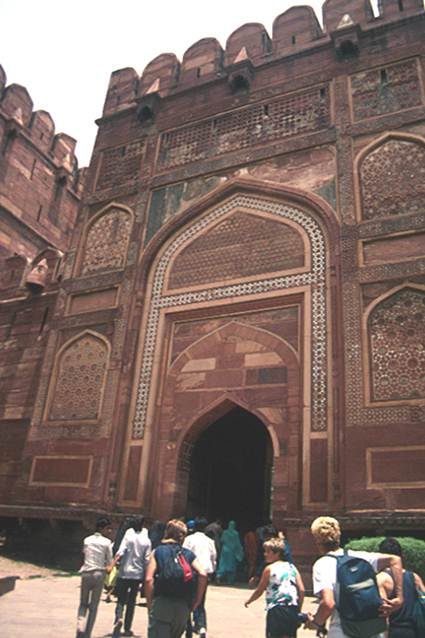
Leave a Reply
You must be logged in to post a comment.